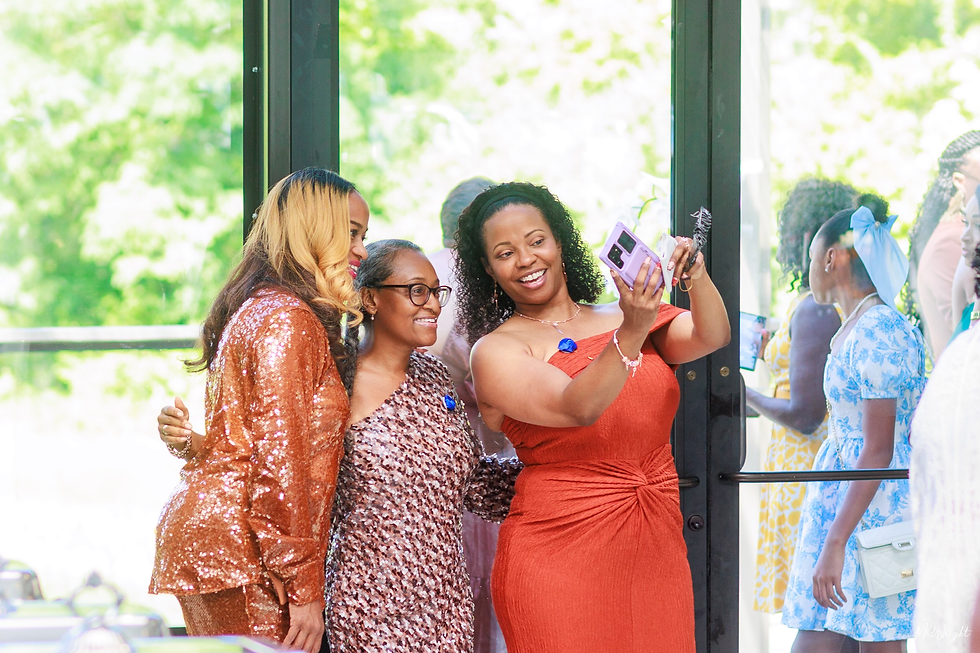How can my brand be diverse and inclusive?
- Shana Fields
- Oct 8, 2021
- 7 min read
Updated: May 22, 2023
Maybe you’re a business owner looking to improve the diversity and inclusivity of your brand. Maybe you’ve already discovered the importance of being a diverse and inclusive brand and are here reading this article hoping to pick up some pointers or to gain some reassurance that you’re on the right path. Whatever your reason, I’m glad you’re here with an interest in this topic.

First, let’s align on defining diversity and inclusion. I’m using the definitions by Meg Bolger, a social justice facilitator and founder of Same Team (an organization committed to helping companies deepen their diversity, equity, and inclusion work), written for General Assembly: Diversity“of identities, like race and gender identity (the current hot topics) and, in some cases, ethnicity, religion, nationality, or sexual orientation.”
Inclusion “is about folks with different identities feeling and/or being valued, leveraged, and welcomed within a given setting (e.g., your team, workplace, or industry). A past participant of mine shared with me the wise words of longtime DEI educator Verna Myers: ‘Diversity is being asked to the party. Inclusion is being asked to dance.’”
Aligning on the meaning of diversity and inclusion is critical because, to quote Bolger, “If we aren’t clear on the words and ideas, how will we be clear on the solutions?” The key actions towards diversity and inclusion that I will recommend for your brand will be based on my story, experiences, and unique perspective.
I’ve been in the ad industry for over 15 years, working with everything from start-ups to Fortune 500 brands, and am currently working independently with small brands and as a consultant for ad agencies. I’ve worn many hats throughout my career, but my specialty is brand strategy. I’m also a first generation Korean American. My personal experiences shape my work as an advocate for diverse and inclusive representation.
I grew up in San Antonio, Texas (in the 80s & 90s to age myself). As diverse as some may think San Antonio can be, the Asian population was very small when I was growing up. The Asian and Asian American population has grown significantly since then, but during my childhood and teen years, I did not see many other people like me in my day-to-day life. It wasn’t until I went away to college that I was exposed to a bigger Asian population extending outside my small immediate family.

If you compound the environment of my upbringing with that of what I saw, or rather didn’t see, in the media, I started to feel invisible or felt a lack of validation for appreciating myself as-is. Also, with the very sparse representation of Asian American women in the media, I was often compared to Michelle Kwan by strangers and friends. It was great to see Michelle Kwan celebrated in the media while I was growing up, but the magazines I read as a teen like Young & Modern (YM) and Seventeen—the articles, ads, and models—predominantly catered to a white audience. This was especially true of tutorials or ads around eyeliners and eyeshadows that were represented as the gold standard of beauty but were outside of my monolid reality (in addition to the inside pressure job of my mother who wanted me to get the popular double eyelid surgery).
Later in life, I would find myself on the other side working in the ad industry and using my voice for diverse representation in advertising as a response to what I didn’t see growing up. It is with this personal viewpoint—that of being invisible in media representation and feeling like I was living in a world whose standards I was never to meet—that I tackle every problem and potential opportunity I am presented with professionally. Maybe, just maybe, if we all view our work and our influence through the eyes of someone on the outside, we can start to cultivate a more inclusive culture that strives to see, hear and validate even the most marginalized and historically excluded members of our society.
If this sounds like a viewpoint you want to adopt as well, I’m glad you’re here. Let’s roll up our sleeves together and dive into the work we can all be doing to make a difference, not only in our businesses but with friends, family, and within ourselves as well.
Start by looking inward at your “why?”
Creating a diverse and inclusive brand goes deeper than diverse models you show on your Instagram feed or using “diversity” and “inclusivity” as buzz words. It starts with you. Why do you want your brand to be diverse and inclusive? What does diversity and inclusivity mean to you? Are you committed to the inner work (for both yourself and for your business at large) authentically and for the long haul before marketing yourself as a diverse and inclusive brand? Are you willing to make business decisions that support diversity even if it requires more effort, taking risks, etc., in order to walk the walk? These are a few examples of questions to think through and get honest about before integrating diversity and inclusion into your branding.
If you’re interested in digging deeper into this topic, here are a few courses to help you along your journey:
Udemy: Offers free and paid courses
Coursera: Diversity and Inclusion in the Workplace; You can audit the course for free before deciding to purchase the course ($49 USD)
General Assembly: Diversity, Inclusion and Equity 101: ($55 USD)
eCornell: Diversity and Inclusion Training Certificate: A robust course with a certification upon completion ($3,600 USD)
Who makes up your team, vendors, and partners?
Do your team and business partners reflect today’s growing diverse world? Business is all about who you know. And often who you know are people who look, think, and act like you. The next time you have the ability to engage others in your work or to grow your team, I encourage you to try to step outside of your work “culture fit” or comfort zone and give someone new who is outside of your circle an opportunity to work with you, or plan a budget to invest in talent outside of your known network. They can provide a new and valuable point of view, expertise, and approach that can be a healthy change and potentially shed new insights into the way you’ve been doing or seeing things. It can also open new opportunities as demonstrated by one of my favorite local brands, Sandwich Hag, with their CommUnity platform to “support local businesses, promote inclusion of ALL abilities, as we share our culture through scratch-made Vietnamese cuisine by Chef Reye.” Or, you could be the one to give someone a shot; read about how Val’s Cheesecakes got started. A new perspective means new possibilities for all.
Go beyond traditional customer demographics.
You might think of your customer base by their age, race/ethnicity, where they live, household income, if they have kids or not, etc. You might find this information helpful for your business, but it omits a richer picture of your audience when you are positioning your brand. Think about the “golden thread”—a common interest or need that your audience shares—and why they would choose you. This helps you identify your ideal audience based on their shared interests or lifestyle (a psychographic profile) and can open up your brand to be more inclusive and diverse while still staying true to the core reason they would engage with your brand. For example, think of brands like Summersalt, founded by Reshma Chamberlin and Lori Coulter, that appeal to diverse women with a shared travel mindset who want to be stylish yet comfortable. “Our goal is to help women find their swimwear soulmate so they can enjoy their summer exactly as they are. We believe summer should be a time of pure happiness,” said Coulter for PEOPLE. Danielle Mak, Business Intelligence senior analyst, who reviewed their swimsuit for Insider said, “I also appreciate how inclusive the site is with model and sizing diversity. The models are of different ages, body types, and ethnicities, and the sizing goes up to 22. It feels good to see this represented.” Summersalt’s effort to represent diverse women goes beyond what you see and they stay true to the core of their brand and their audience through the common thread of inclusive and flattering swimwear for women who are going places.
Are you willing to listen + take action?
As a small business owner, I understand most of us are wearing many hats, but it is crucial to carve out the time to know and listen to your audience—then keep listening to them. This is naturally part of the customer service aspect of your business, but it can also provide great insights and opportunities to continue to walk the walk of your diversity and inclusivity efforts for your brand.
Listening to your audience makes them feel heard and seen by your brand. If your business is able to listen to their input and take action, this can help them feel heard and valued. For example, Zappos launched Zappos Adaptive which includes a Single and Different Size Shoes program. People of all abilities have the opportunity to buy a single shoe or build a pair using different sizes. This program was the result of listening to their customers. “The Single and Different Size Shoes Test Program is very close to our hearts – we wanted our community to know that we heard them, and continue to listen and innovate based on their needs and wants,” said Dana Zumbo, Business Development Manager, Zappos Adaptive. “Customer service is our number one goal, and we’re endlessly committed to ensuring that everyone feels comfortable and confident in their own shoe or shoes.”
So what are some ways you can get to know and listen to your audience and customers?
Read through customer feedback and reviews (look beyond the five-star rating system) on your website, social media, and on Google. Send a short survey to your customers with free tools like Google Forms or Typeform through your email system or on your social media platforms. For simple and quick feedback from your customers, don’t forget about free social media features like Polls on Facebook and Instagram.

How are they engaging with or talking about your brand on social media? Read through post comments, @ tags or hashtags, or simply type your brand name in the search field on Facebook. If you have the budget, use social media listening tools like SproutSocial, Sprinklr, HootSuite, or MomentFeed, among other options. If conducting research and analyzing is not your jam, plan a budget to hire someone to help you.
By going through periodic analysis of your brand and listening to your customers, you can more deeply understand your customers. This not only helps your business see the big picture, but it will ultimately help you nurture a more diverse and inclusive community with your brand for the long haul.
Whether you are at the start of your diversity and inclusion journey or are well on your way, these tips can help your brand break through the noise by including every voice in the conversation. And maybe, there is a young Shana out there who will feel seen and represented by your brand…and a greater appreciation for her beautiful monolid eyes.
Kelly Liang, Kierra Winston, and Arion Pierce photographed by Nidhi Masih; Article by Shana Fields
















Comments